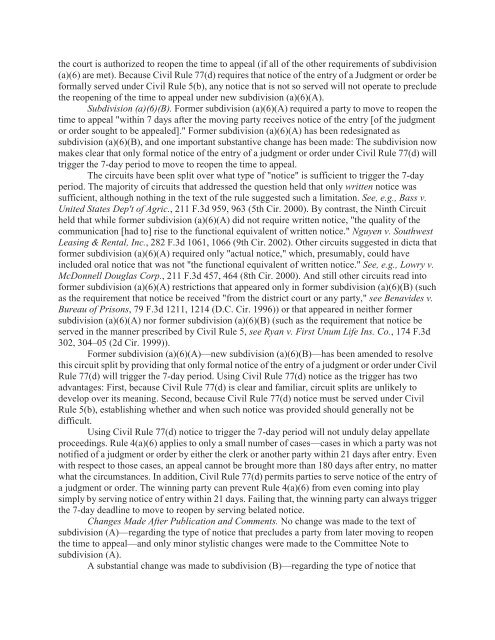Federal Rules of Appellate Procedure 2014-2015, 2014a
Federal Rules of Appellate Procedure 2014-2015, 2014a
Federal Rules of Appellate Procedure 2014-2015, 2014a
Create successful ePaper yourself
Turn your PDF publications into a flip-book with our unique Google optimized e-Paper software.
the court is authorized to reopen the time to appeal (if all <strong>of</strong> the other requirements <strong>of</strong> subdivision<br />
(a)(6) are met). Because Civil Rule 77(d) requires that notice <strong>of</strong> the entry <strong>of</strong> a Judgment or order be<br />
formally served under Civil Rule 5(b), any notice that is not so served will not operate to preclude<br />
the reopening <strong>of</strong> the time to appeal under new subdivision (a)(6)(A).<br />
Subdivision (a)(6)(B). Former subdivision (a)(6)(A) required a party to move to reopen the<br />
time to appeal "within 7 days after the moving party receives notice <strong>of</strong> the entry [<strong>of</strong> the judgment<br />
or order sought to be appealed]." Former subdivision (a)(6)(A) has been redesignated as<br />
subdivision (a)(6)(B), and one important substantive change has been made: The subdivision now<br />
makes clear that only formal notice <strong>of</strong> the entry <strong>of</strong> a judgment or order under Civil Rule 77(d) will<br />
trigger the 7-day period to move to reopen the time to appeal.<br />
The circuits have been split over what type <strong>of</strong> "notice" is sufficient to trigger the 7-day<br />
period. The majority <strong>of</strong> circuits that addressed the question held that only written notice was<br />
sufficient, although nothing in the text <strong>of</strong> the rule suggested such a limitation. See, e.g., Bass v.<br />
United States Dep't <strong>of</strong> Agric., 211 F.3d 959, 963 (5th Cir. 2000). By contrast, the Ninth Circuit<br />
held that while former subdivision (a)(6)(A) did not require written notice, "the quality <strong>of</strong> the<br />
communication [had to] rise to the functional equivalent <strong>of</strong> written notice." Nguyen v. Southwest<br />
Leasing & Rental, Inc., 282 F.3d 1061, 1066 (9th Cir. 2002). Other circuits suggested in dicta that<br />
former subdivision (a)(6)(A) required only "actual notice," which, presumably, could have<br />
included oral notice that was not "the functional equivalent <strong>of</strong> written notice." See, e.g., Lowry v.<br />
McDonnell Douglas Corp., 211 F.3d 457, 464 (8th Cir. 2000). And still other circuits read into<br />
former subdivision (a)(6)(A) restrictions that appeared only in former subdivision (a)(6)(B) (such<br />
as the requirement that notice be received "from the district court or any party," see Benavides v.<br />
Bureau <strong>of</strong> Prisons, 79 F.3d 1211, 1214 (D.C. Cir. 1996)) or that appeared in neither former<br />
subdivision (a)(6)(A) nor former subdivision (a)(6)(B) (such as the requirement that notice be<br />
served in the manner prescribed by Civil Rule 5, see Ryan v. First Unum Life Ins. Co., 174 F.3d<br />
302, 304–05 (2d Cir. 1999)).<br />
Former subdivision (a)(6)(A)—new subdivision (a)(6)(B)—has been amended to resolve<br />
this circuit split by providing that only formal notice <strong>of</strong> the entry <strong>of</strong> a judgment or order under Civil<br />
Rule 77(d) will trigger the 7-day period. Using Civil Rule 77(d) notice as the trigger has two<br />
advantages: First, because Civil Rule 77(d) is clear and familiar, circuit splits are unlikely to<br />
develop over its meaning. Second, because Civil Rule 77(d) notice must be served under Civil<br />
Rule 5(b), establishing whether and when such notice was provided should generally not be<br />
difficult.<br />
Using Civil Rule 77(d) notice to trigger the 7-day period will not unduly delay appellate<br />
proceedings. Rule 4(a)(6) applies to only a small number <strong>of</strong> cases—cases in which a party was not<br />
notified <strong>of</strong> a judgment or order by either the clerk or another party within 21 days after entry. Even<br />
with respect to those cases, an appeal cannot be brought more than 180 days after entry, no matter<br />
what the circumstances. In addition, Civil Rule 77(d) permits parties to serve notice <strong>of</strong> the entry <strong>of</strong><br />
a judgment or order. The winning party can prevent Rule 4(a)(6) from even coming into play<br />
simply by serving notice <strong>of</strong> entry within 21 days. Failing that, the winning party can always trigger<br />
the 7-day deadline to move to reopen by serving belated notice.<br />
Changes Made After Publication and Comments. No change was made to the text <strong>of</strong><br />
subdivision (A)—regarding the type <strong>of</strong> notice that precludes a party from later moving to reopen<br />
the time to appeal—and only minor stylistic changes were made to the Committee Note to<br />
subdivision (A).<br />
A substantial change was made to subdivision (B)—regarding the type <strong>of</strong> notice that


















